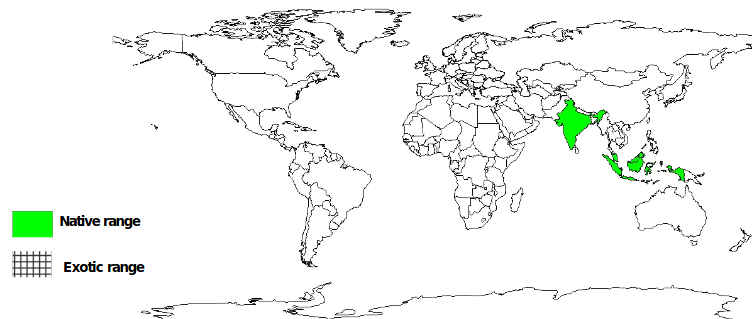Publication
from Agroforestree Database: a tree reference and selection guide version 4.0
by C. Orwa, A. Mutua, R. Kindt, R. Jamnadass and S. Anthony
Syzygium samarangense (Blume) Merr. & Perry
Local Names: English
(wax-apple, water apple, malay apple, Java apple); Filipino (makopa);
Indonesian (jambu klampok); Malay (jambu air mawar); Thai
(chomphu-khieo); Vietnamese (roi)
Family: Myrtaceae
Botanic Description
Syzygium samarangense is a tree to 15 m tall, with short and
crooked trunk, 25-50 cm diameter, often branched near the base and with
wide, irregular canopy.
Leaves opposite, elliptic to
elliptic-oblong, 10-25 cm x 5-12 cm, coriaceous with thin margin,
pellucid dotted, rather strongly aromatic when bruised; petiole thick,
3-5 mm long.
Inflorescences terminal and in axils of fallen
leaves, 3-30-flowered; flowers 3-4 cm in diameter, calyx-tube ca. 1.5
cm long, ventricose at apex, lobes 3- 5 mm long; petals 4, orbicular to
spathulate, 10-15 mm long, yellow-white; stamens numerous, up to 3 cm
long; style up to 3 cm long.
Fruit a berry, broadly pyriform,
crowned by the fleshy calyx with incurved lobes, 3.5-5.5 cm x 4.5-5.5
cm, light red to white; flesh white spongy, juicy, aromatic, sweet-sour
in taste.
Seeds 0-2, mostly suppressed, globose, up to 8 mm in diameter.
Ecology
Shoot
growth proceeds in flushes which are more or less synchronous,
depending on the climate. The juvenile period lasts for 3-7 years.
Bearing of clonal trees starts after 3-5 years. There are definite
flowering seasons, often two, sometimes three in a year, but the timing
varies from year to year. Wax jambu commonly flowers early or late in
the dry season; the flowers appear to be self-compatible and the fruit
ripens 30-40 days after anthesis.
The trees are at home in
fairly moist tropical lowlands up to 1200 m elevation. Wax jambu grows
best in areas with a fairly long dry season. This does not mean that
this species is drought-resistant. The species require a reliable water
supply and are often planted along streams or ponds.
Biophysical Limits
Altitude: Up to 1200 m.
Soil types: The trees prefer heavy soils and easy access to water instead of having to search for water in light deep soils.
Documented Species Distribution
Native: Fiji, India, Indonesia, Malaysia
Exotic:

The
map above shows countries where the species has been planted. It does
neither suggest that the species can be planted in every ecological
zone within that country, nor that the species can not be planted in
other countries than those depicted. Since some tree species are
invasive, you need to follow biosafety procedures that apply to your
planting site.
Products
Food:
The tree is grown for their fruit, which substitute for one another in
the marketplace. It is not easy to distinguish between the various S.
aqueum and S. samarangense fruits. The ripe fruit is sweet and is
mainly eaten fresh. In Indonesia wax jambu is used in fruit salads
('rujak') and they are also preserved by pickling ('asinan'). Eighty
per cent or more of the fruit is edible. The composition the species
per 100 g edible portion: water more than 90%, protein 0.3 g, fat none,
carbohydrates 3.9 g, fibre 1 g, vitamin A 253 IU, vitamin B1 and B2
traces, vitamin C 0.1 mg, energy value 80 kJ/100 g (analysis for wax
jambu in Thailand).
Timber: The wood is reddish, hard and grows to dimensions large enough for construction purposes.
Medicine: Various parts of the tree are used in traditional medicine, and some have in fact been shown to possess antibiotic activity.
Tree Management
Tree
spacing ranges from 8-10 m. The trees receive little attention after
the first year or two when manuring, weeding, mulching and watering
ensure rapid increase of tree volume. Trees which bear well benefit
from compound fertilizers applied after harvest and supplemented with a
top dressing as soon as the inflorescences are being formed. There
appears to be no experience with pruning or fruit thinning. The fruits
have a thin skin and are delicate; they need to be picked by hand twice
a week and handled with care. The fruit should be consumed or preserved
within a few days from harvest. A five-year-old wax jambu may yield 700
fruit.
Pests and Diseases
There
are no specific recommendations for crop protection, but the incidence
of pests and diseases certainly warrants a study of the causal
organisms and their control.
Further Reading
CSIR. 1976. The Wealth of India: Raw materials. Vol X Sp-W. CSIR.
Jensen
M. 1995. Trees commonly cultivated in South-East Asia: An illustrated
field guide. RAP publication: 1995/38. Bangkok, Thailand. 229pp.
Martin
FW, Campbell CW & Ruberte RM. 1987. Perennial edible fruits of
tropics: an inventory. US Department of Agriculture, Agriculture
Handbook No. 642. 252 pp.
Morton J. 1987. Malay Apple. In: Fruits of warm climates. Creative Resource Systems, Winterville, N.C. pp. 378-383.
Okuda,
TT, Yoshida, Hatamo, T, Yazaki, K, & Ashida, M. 1982. Ellagitannins
of the Casuarinaceae, Stachyuraceae and Myrtaceae. Phytochemistry.
21(12): 2871-2874.
Panggabean G.1992. Syzygium aqueum (Burm.f.) Alst., Syzygium malaccense (L.) M. & P, and Syzygium samarangense
(Blume) M. & P. In Coronel, R.E., et al. (Eds.): PROSEA. No. 2:
Edible fruits and nuts. Prosea Foundation, Bogor, Indonesia. pp.
292-294.
Walter A, Sam C. 2002. Fruits of Oceania. ACIAR Monograph No. 85. Canberra. 329 pp.
|
|